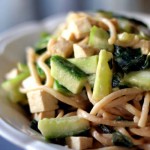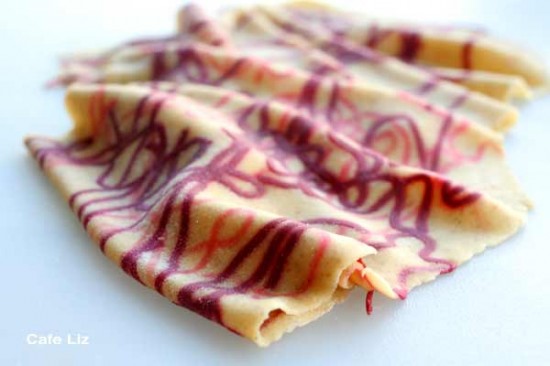
These swirly, patterned ribbons would look quite nice hung on my wall. Were they not made of pasta dough, that is.
Back story: We are now the proud new owners of a pasta maker. I know everyone says you can make perfectly good pasta by hand, too, but frankly, there's no comparison. We've never been able to roll our pasta thin enough. Plus, the machine is extremely useful when it comes to kneading.
Once you have a machine to do your rolling, kneading and cutting, the options are pretty endless. I whipped up a few different kinds of dough, including a fuchsia-colored beet dough and some whole wheat. These made for some excellent combinations.
Getting the scribbled pattern effect that I achieved is quite easy -- easier than making tidy stripes. Basically, I made thin spaghetti out of the beet dough, let it dry a bit, and then pressed it randomly into the neutral-colored whole wheat dough. Voila, instant art, with a major wow! factor.
Making the dough
Pasta dough needs to be pretty dry if you're going to run it through the machine. Otherwise, it'll stick to itself, or worse, your machine. Plus, it's easier to work with once it's rested for a while (most recipes say an hour). I usually make mine a day in advance, and it keeps in the fridge for up to two weeks, maybe more, even -- I've never left it longer than that.
With that in mind, here are the basic dough recipes I used:
For the whole wheat dough:
250 grams whole wheat flour
‪250 grams semolina flour (סולת)‬
1 to 1 1/4 cup water
Add the water to the flour, just enough to make the dough hold together. Knead as you go. The dough should be elastic, but very stiff, more so than bread dough. It should not be sticky at all.
For the beet dough:
250 grams cooked, peeled beet (I cooked mine in a covered glass bowl in the microwave for 10-15 minutes)
250 grams whole wheat or white flour
250 grams semolina flour
water, if necessary
Blend the ingredients in a food processor. As above, the dough should hold together, but be very stiff and not sticky. Add more flour if your dough is even slightly sticky.
Rolling the dough
Cut off a chunk of beet dough slightly smaller than a tennis ball. Smash it between your palms into a patty, dust with flour, and then feed it into your pasta machine on the thickest setting. It may break into large chunks. That's OK. Squish the chunks together, two layers thick, into a sheet of sorts. Feed this through the machine. Fold the sheet (or chunks) in half and repeat. Do this until the dough feels smooth and consistent (and obviously, is not falling apart anymore). If the dough ever feels slightly sticky, dust both sides with flour.
Once your dough is soft and springy, you can start flattening it -- put the machine on thickness #2, roll the dough through, flour lightly, and repeat with #3, #4 and #5 (1/16 of an inch thick, or 1.6 millimeters). Flour again, and run through the spaghetti attachment (1-millimeter-wide noodles). Dust the noodles with flour, and set aside to dry.
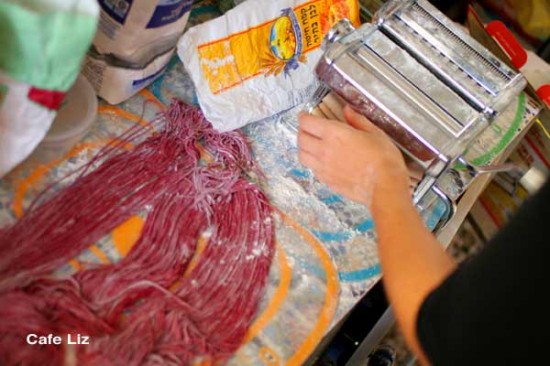
You think that's a lot of flour on my table? You should see my floor.
Repeat with a chunk of whole wheat flour, rolling it down to #4 (5/64 of an inch, or 2 millimeters).

Assembling the stripes
Lay the strip of whole wheat dough flat, and arrange purple noodles on top of it. You don't want clumps, because these will flatten into purple blobs, but other than that, you can make whatever patterns you want. Gently press the noodles in place with your hands.
Run the dough through the machine on #3, and then #4.

No machine? No problem
Despite what I said at the beginning, you could, in theory, make this without a pasta machine, with a rolling pin and a lot of patience. You probably couldn't get the purple noodles into quite so thin strips, but you could make other interesting patterns. In this asparagus-eggplant pasta recipe [1], for instance, I made my pasta dough by hand.
What to do with your decorated dough
I made mine into ravioli, as well as thick linguini noodles. These looked remarkably like bacon once cooked. You could also make this into lasagna, or cannelloni.
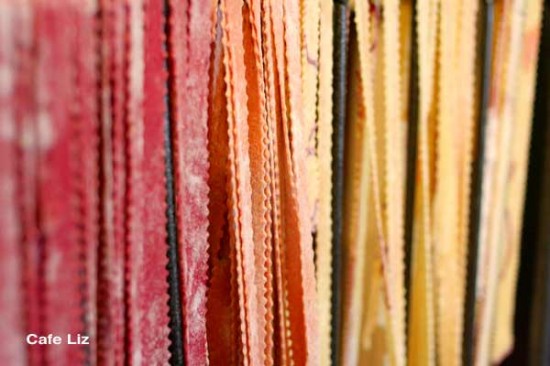
In the photo, from left: Beet noodles, noodles made from a mixture of beet and whole wheat flour, and whole wheat noodles with beet stripes.
Cooking the pasta
Unlike dry pasta, homemade pasta cooks very quickly. Bring a pot of salted water to a boil, add the noodles (but not too much that the water stops boiling), and taste every 30 seconds or so.
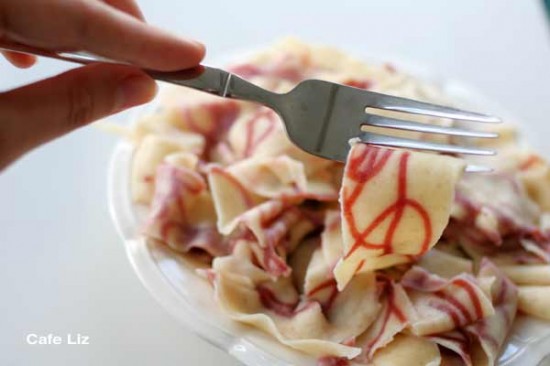
More pasta maker tips
Two basic rules: NEVER get the machine wet (it'll rust), and NEVER put anything aside from dough between the blades (this will dull them).
What to do if your dough goes stickily, horribly wrong? (It will, at some point.) Pull off as much as you can, remove any remaining large chunks with a toothpick or paper towel, dust heavily with flour, and keep on going. Or, let it dry and then flake it off with a paper towel or a soft toothbrush. Remember, don't rub anything against any cutting blades.
You can find more instructions for the Atlas at Fante's Web site [2].
Where to buy pasta machines
I got a Marcato Atlas 150 [3], one of the most popular and reputable machines. Cooks in the U.S. can find them on Amazon -- either the basic machine here [4], or a box set with multiple pasta shape attachments [5], which is what I have (it's a better deal than buying all the cutters individually). Cooks in Israel also can get these machines for pretty reasonable prices -- only about 25% more than what the manufacturer in Italy is asking.
I got mine at Tischler's [6], at Montefiore 22, because they had the best prices I could find in Tel Aviv. Cooking stores like 4chef [7] also carry them, albeit for higher prices. The overall cheapest store I found was Itzhik Cohen [8], in Kfar Sava.
